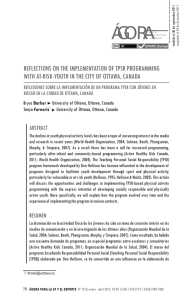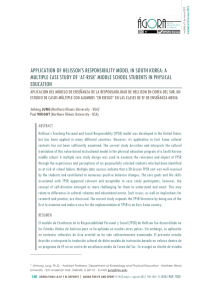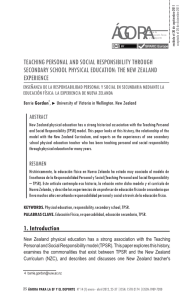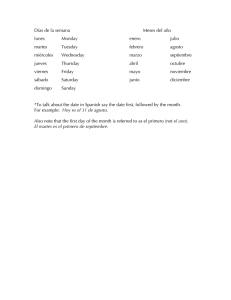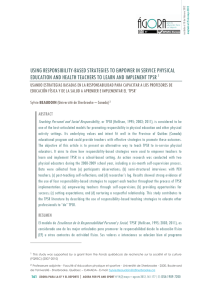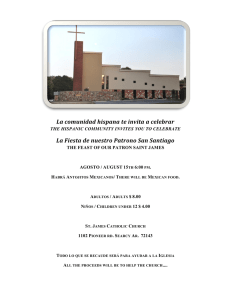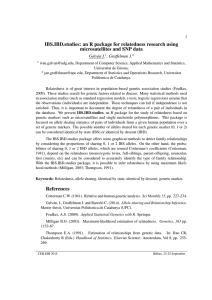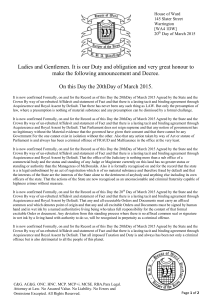forecasting the storm: student perspectives throughout a teaching
Anuncio
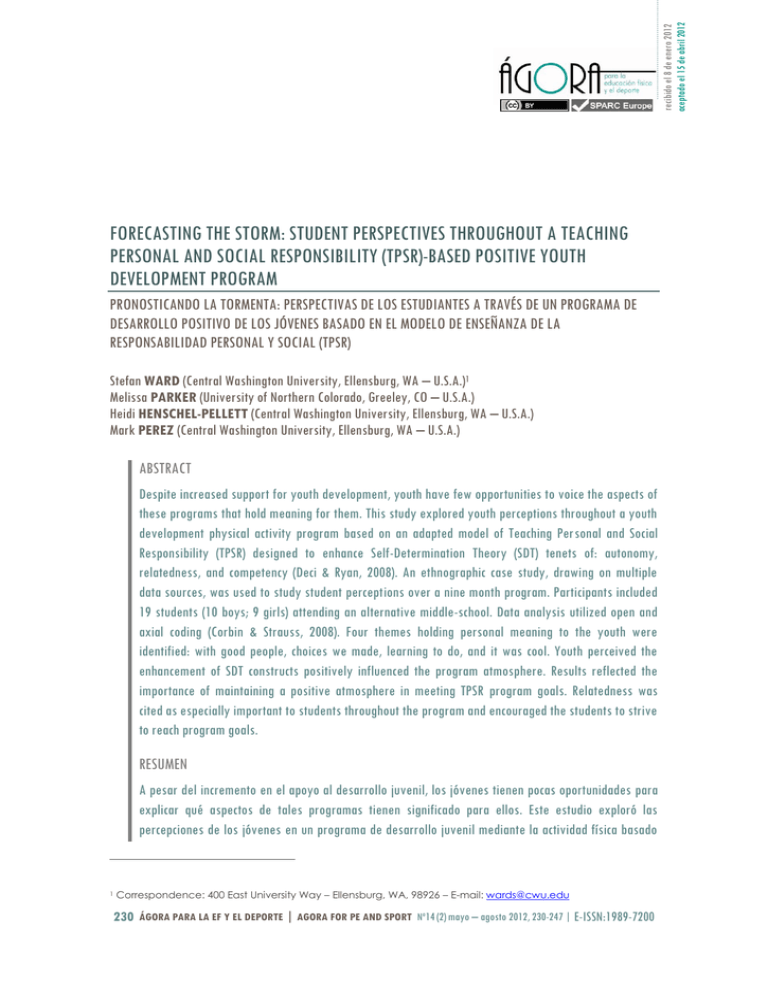
recibido el 8 de enero 2012 aceptado el 15 de abril 2012 FORECASTING THE STORM: STUDENT PERSPECTIVES THROUGHOUT A TEACHING PERSONAL AND SOCIAL RESPONSIBILITY (TPSR)-BASED POSITIVE YOUTH DEVELOPMENT PROGRAM PRONOSTICANDO LA TORMENTA: PERSPECTIVAS DE LOS ESTUDIANTES A TRAVÉS DE UN PROGRAMA DE DESARROLLO POSITIVO DE LOS JÓVENES BASADO EN EL MODELO DE ENSEÑANZA DE LA RESPONSABILIDAD PERSONAL Y SOCIAL (TPSR) Stefan WARD (Central Washington University, Ellensburg, WA – U.S.A.)1 Melissa PARKER (University of Northern Colorado, Greeley, CO – U.S.A.) Heidi HENSCHEL-PELLETT (Central Washington University, Ellensburg, WA – U.S.A.) Mark PEREZ (Central Washington University, Ellensburg, WA – U.S.A.) ABSTRACT Despite increased support for youth development, youth have few opportunities to voice the aspects of these programs that hold meaning for them. This study explored youth perceptions throughout a youth development physical activity program based on an adapted model of Teaching Personal and Social Responsibility (TPSR) designed to enhance Self-Determination Theory (SDT) tenets of: autonomy, relatedness, and competency (Deci & Ryan, 2008). An ethnographic case study, drawing on multiple data sources, was used to study student perceptions over a nine month program. Participants included 19 students (10 boys; 9 girls) attending an alternative middle-school. Data analysis utilized open and axial coding (Corbin & Strauss, 2008). Four themes holding personal meaning to the youth were identified: with good people, choices we made, learning to do, and it was cool. Youth perceived the enhancement of SDT constructs positively influenced the program atmosphere. Results reflected the importance of maintaining a positive atmosphere in meeting TPSR program goals. Relatedness was cited as especially important to students throughout the program and encouraged the students to strive to reach program goals. RESUMEN A pesar del incremento en el apoyo al desarrollo juvenil, los jóvenes tienen pocas oportunidades para explicar qué aspectos de tales programas tienen significado para ellos. Este estudio exploró las percepciones de los jóvenes en un programa de desarrollo juvenil mediante la actividad física basado 1 Correspondence: 400 East University Way – Ellensburg, WA, 98926 – E-mail: [email protected] 230 ÁGORA PARA LA EF Y EL DEPORTE | AGORA FOR PE AND SPORT Nº14 (2) mayo – agosto 2012, 230-247 | E-ISSN:1989-7200 STEFAN WARD ET AL. Forecasting the storm: Student perspectives in a TPSR program en una adaptación del modelo de Enseñanza de la Responsabilidad Personal y Social (TPSR) diseñado para desarrollar los principios de la Teoría de la Auto-Determinación (STD): autonomía, sociabilidad y competencia (Deci & Ryan, 2008). Las percepciones de los estudiantes se estudiaron a partir de las múltiples fuentes de datos de un estudio de caso etnográfico que se realizó durante un programa de nueve meses. Los participantes fueron 19 jóvenes (10 chicos y 9 chicas.), estudiantes de secundaria de una escuela alternativa. El análisis de datos se llevó a cabo mediante la codificación abierta y axial (Corbin y Strauss, 2008). Se identificaron cuatro temas que contenían un significado personal para los jóvenes: con buena gente, las opciones que tomamos, aprendiendo a hacer, y fue divertido (estuvo bien). Los jóvenes percibieron que la mejora en los principios del STG influía positivamente en la atmósfera del programa. Los resultados indicaron cuán importante es mantener un clima positivo a fin de conseguir los objetivos del programa TPSR. Los estudiates atribuyeron especial importancia a las buenas relaciones, las cuales, a su vez, estimulaban su esfuerzo para alcanzar los objetivos del programa. KEYWORDS. Youth development; TPSR; self-determination theory. PALABRAS CLAVE. Desarrollo juvenil; TPSR; teoría de la auto-determinación. 1. INTRODUCTION Positive youth development (PYD) supports the idea that all children have strengths and assets to be promoted and nurtured rather than deficits that require “fixing” (Benson, 2006). Many students, however, in both rural and urban settings have basic needs that are not being met. Risk factors for youth are rising including violence, crime, and neglect (Schilling & Martinek, 2000). In addition to these rising risk factors, the social influences of family and community ties are weakening. Combined these have had a tremendous negative impact for underserved youth, as these social institutions have historically nurtured their development (Catalano et al., 1999; Roth & Brooks-Gunn, 2003; United States Department of Health and Human Services, 2007; Weissberg & Greenberg, 1997). Many youth feel overwhelmed and claim to be working “just to live, to duck the bullet” (McLaughlin, Irby, & Langman, 1994, p. 19). Positive youth development programs, which reflect the desired outcomes for youth encompassing society’s hopes and aspirations for a nation of healthy, happy, and productive individuals, have been created to attempt to strengthen the inner resources of youth so they can live up to their full potential (Dworkin, Larson, & Hansen, 2003; Larson, 2000; Roth, Brooks-Gunn, Murray, & Foster, 1998). In the realm of physical activity these programs have flourished (Brustad, Parker, & Stiehl, 2006). These physical activity programs have been successful in a variety of settings including: schools, extracurricular, sports, and summer camps (Dworkin, Larson, & Hansen, 2003). One of the earliest and most prominent of these physical activity programs is Hellison’s (2011) Teaching Personal and Social Responsibility (TPSR). It began in the late 1970s and developed into a curricular (Hellison & Martinek, 2006; Walsh, 2007) and instructional Nº14 (2) mayo – agosto 2012, 230-247 ÁGORA PARA LA EF Y EL DEPORTE | AGORA FOR PE AND SPORT 231 STEFAN WARD ET AL. Forecasting the storm: Students perspectives in a TPSR program model (Metzler, 2012) to promote responsibility and life skills that students can practice and then transfer to other settings. It provides a framework for empowering youth to be responsible for their actions and learning through a physical setting (Hellison, 2011). The model slowly began to grow as it found kindred spirits in teachers and professors interested in helping underserved populations (Hellison, Cutforth, Kallusky, Martinek, Parker, & Stiehl, 2000; Hellison & Martinek, 2006). Reviews of the TPSR literature indicate the success of this model in the physical activity settings including extended day programs, after school programs, and even physical education classes (Hellison & Walsh, 2002; Li, Wright, Rukavina, & Pickering, 2008). Strong support has been shown for the model’s ability to facilitate students taking responsibility for their own development and for the well-being of others (Hellison & Martinek, 2006). The creation of a positive learning environment or atmosphere has also been shown to be an important component of TPSR. The environment can influence program commitment because opportunities and activities can facilitate or inhibit student commitment and engagement (Hellison & Martinek, 2006; Schilling, 2001). These program practices can be positive or negative. They can either be barriers creating negative effects or they can facilitate an atmosphere crafted to make the students feel safe both physically and psychologically (Hellison, 2011; Schilling, Martinek, & Carson, 2007). An important aspect of this atmosphere creation is allowing student voice. This practice is crucial to any educational process, yet students are not often consulted to express what they contribute and take away from a program (Graham, 1995; Thomson, 2008). Positive program atmosphere in a PYD program is a fusion of youth and adult voice (Ward & Parker, 2009). Therefore, it is imperative that student input be considered to maximize the potential benefits. This synthesis of both voices is influenced by; personal characteristics, interpersonal relationships, accepting cultural differences, and sound pedagogical practices (Li, et al., 2008; Ward& Parker, 2009; Wright & Burton, 2008). 2. THEORETICAL FRAMEWORK Self-Determination Theory (SDT) provides a useful framework for examining atmosphere in TPSR programs. This theory states that for a person to be psychologically healthy, their needs of competence, autonomy, and relatedness must be met (Deci & Ryan, 2008). Autonomy acknowledges self-rule, self-initiation, self-volition, and willing endorsement of one’s behavior. Competence refers to the propensity to experience challenge and mastery in one’s own activity. Relatedness is the need to belong or tendency to be oriented toward forming stable and strong inter-personal ties (Deci & Ryan, 2008). The tenets of SDT align closely with teaching students to take responsibility and providing strong relatedness with a caring adult (Ward& Parker, 2009). Utilizing the TPSR model to enhance the tenets of SDT approach to ground PYD programs is promising, but is only possible to the extent that it is well implemented pedagogically. For instance, SDT suggests that children have needs which must be met for successful growth (Deci & Ryan, 2008; Guay, Ratelle, & Chanel, 2008); however, 232 ÁGORA PARA LA EF Y EL DEPORTE | AGORA FOR PE AND SPORT Nº14 (2) mayo – agosto 2012, 230-247 STEFAN WARD ET AL. Forecasting the storm: Student perspectives in a TPSR program fostering these needs is not automatic, rather it is more likely to occur if purposefully implemented through sound pedagogical practices, such as those presented in the framework of TPSR (Gordon, 2009; Hellison, 2011; Lund &Veal, 2008). Thus, if autonomy is a basic need which must be met, then in a pedagogical sense, this relates to creating student choice related to control over their environment (Hellison & Martinek, 2006; Hellison & Walsh, 2002). Relatedness can be facilitated by providing daily opportunities for youth to interact with positive caring adults and each other (Hellison, 2011). Competence can be incorporated by providing sound instructional practices geared towards student learning in the psychomotor domain. This is not always done, as many well meaning individuals lack the training or time to implement these procedures. The purpose of this study was to explore youth responses to and perceptions of a TPSR physical activity program designed to enhance competence, autonomy, and relatedness. 3. METHODOLOGY The qualitative research design utilized was an ethnographic case study. The case study used a purposeful selection of a specific bounded unit to better understand the individual case, rather than solely attempting to generalize to other populations (Patton, 2008). The case examined was an alternative middle-school physical education class. Participants and Context Participants included an intact 7th/8th grade class of 19 middle school students (10 males; 9 females). The students’ ethnicity was primarily European American, with only two of the students having a mixed heritage of Latino and Caucasian. Thirteen of these students voluntarily opted out of the regular middle school, in favor of the smaller alternative school environment. Two of the students were assigned to the alternative school after expulsion from other schools, while four of the students were previously home-schooled and were phasing into the school system. The scholastic levels of the youth ranged from below to above grade level on both their math and reading end-ofgrade tests. The students were from lower and middle income families from an agricultural town in the northwest region of the United States. The school was located on a university campus and consisted of a self-contained class in two adjoining rooms in the education building. The students had a five-minute walk to the field-house where their physical education class was held. The field-house was open and well-lit; approximately the size of four basketball courts, and contained the typical equipment necessary for a physical education teacher education (PETE) program. Portable soccer goals, basketball goals, and other track and field mats were stacked along the upper wall, and a portion of the gym was blocked off containing fitness equipment. Lines delineating various games marked the floor in colorful patterns. Nº14 (2) mayo – agosto 2012, 230-247 ÁGORA PARA LA EF Y EL DEPORTE | AGORA FOR PE AND SPORT 233 STEFAN WARD ET AL. Forecasting the storm: Students perspectives in a TPSR program Program Description and Procedures The program met twice a week for 70 minutes each day, and once a week for 45 minutes for student choice day. The program lasted for an entire school year from September to May. This period was broken down into three trimesters: fall, winter, and spring. It was taught by the primary author who has directed multiple TPSR programs and three programs rooted in SDT experiences. It was co-taught with four physical education2nd year candidates each trimester (twelve teachers total for the year). These students had limited TPSR experience (one class) and no previous exposure to SDT. However, they were all physical education program seniors with three methods classes and numerous content classes. This program served as the physical education for the alternative school; none was provided by the district. The program occurred during the school day, but it was designed to be more studentcontrolled than the typical school physical education setting. To facilitate this studentcontrol, the constructs of SDT were purposefully interwoven into the program. Student choices and opportunities to be responsible allowed for opportunities for autonomy. The instructional design of the program fostered improving the students’ competence in sports and fitness. Relatedness was fostered through multiple daily opportunities provided for the students and adults to bond through class games and activities, smaller, less intimidating groups, and one-on-one interactions. Two parallel curriculums were utilized in the program, TPSR and sport and fitness skills. Both curricula were interwoven together in practice, with the university professor teaching the TPSR/SDT and the PETE students teaching the sport and fitness skills. The first curriculum was a modification of Hellison’s TPSR model (2011) infused with an emphasis on the constructs of SDT (relatedness, competence, and autonomy) (see Figure 1, next page). This modified design was closely aligned to Hellison’s five levels except for the changes in the levels of “helping others” and “transfer outside the gym”. “Helping others” was customized to “leadership initiative” and focused on being at a higher level of participation and doing things for your team without being asked. “Outside the gym” was renamed to “Goal for life”. Although it was the same concept as transferring learning outside the program, the name was changed to utilize sport imagery to facilitate students using what they learned in their lives outside of class. These levels were referred to as goals and placed in a circular pattern to avoid a feeling of hierarchy with the students. The idea was presented that the four little goals lead to the ultimate big goal. 234 ÁGORA PARA LA EF Y EL DEPORTE | AGORA FOR PE AND SPORT Nº14 (2) mayo – agosto 2012, 230-247 STEFAN WARD ET AL. Forecasting the storm: Student perspectives in a TPSR program Self-Control Effort • Didn’t bother others • Listening when others talk • Worked hard the whole time • Stayed on task • Tried new things • Practiced a skill I am good at • Not talking while others talk Goal! For Life Respect Leader Initiative • Listened to others • Listened to the teachers • Didn’t call names • Practiced on my own • Cheered on others • Practiced a skill I am not good at • Helped my team • Didn’t foul • Held the equipment while others talked Figure 1. Modified TPSR Design The second curriculum of sport and fitness was taught in nine week units and included dance/team handball, basketball/fitness/weights, and soccer/fitness/weight training (sport skills on Tuesdays and fitness on Thursdays). These options were chosen by the students from a list offered to them at the beginning of the year and were geared towards teamwork, tactics, and game play. Competence was increased through the teaching fitness concepts and game skills were taught in reference to tactics and game play. Autonomy was maximized through instructional strategies providing increased opportunities for the youth to design and structure their practice time as the unit progressed. These opportunities included players assuming responsibility and commitment to the program by helping to create norms and rules, and assuming leadership positions during practices such as coaches, trainers, captains, etc. Relatedness was fostered by breaking the class up into small groups of four or five students, so that the instructors could interact each day with each student in friendly open manner. The instructors purposely set out to get to know the students and provide feedback consistently to the same students. This teaching was based on small group interactions allowing for choices by the students and instructors as to what tactics and skills to work on, what plays to practice, and the ratio of practice to game play. A typical day included free-play as the students entered, an awareness talk, group practice or play, and reflection time (Hellison, 2011). The awareness talk reinforced daily and programmatic goals and reminded students about their personal goals. The larger Nº14 (2) mayo – agosto 2012, 230-247 ÁGORA PARA LA EF Y EL DEPORTE | AGORA FOR PE AND SPORT 235 STEFAN WARD ET AL. Forecasting the storm: Students perspectives in a TPSR program group would then divide into four smaller groups, each with an adult leader for the lesson. While the lead researcher had previously outlined what should happen during the lessons, adults were free to make changes and add their own ideas and activities to the lesson plans to motivate the students and help meet their needs. The students also provided input into practices and would take turns leading various parts of the lesson with contributions from the adults. Practice versus play time varied, but typically play lasted longer and longer toward the end of the unit as the students chose to play more. At the close of each program day, the separate groups would reconvene to have whole group discussions on the sport/fitness and TPSR teachings. Reflection took the form of small group written reflection meetings with an adult leader, and whole group meetings with everyone. Data Collection The study protocol was reviewed and approved by the University Institutional Review Board and the School District Office prior to the beginning of the project. The primary author had previous connections with the school and entered the setting by negotiating the creation of the program with the alternative school faculty. The program was optional as the students could chose to opt out and go to a different setting while the other students participated. Parental consent and student assent forms were obtained. Pseudonyms are utilized to protect the anonymity of the participants as much as possible. Data were collected during the program in the field house and at the alternative school. Data sources included: (a) formal interviews, (b) descriptive video-tape of each lesson and field notes, (c) daily participant reflection journals, (d) and artifacts. Data collection spanned the entire nine-month school year. Interviews. Semi-structured formal interviews (Fontana & Frey, 2000) with the 19 participants were conducted after the program ended. They took place in a classroom at the alternative school site and constituted the primary data source. Predetermined open-ended questions were generated from the TPSR, SDT, and PYD literature, field notes, reflection journals, and artifacts. Interviews ranged from fifteen to thirty minutes. All interviews were conducted by the lead author, digitally recorded, and transcribed verbatim. Participant reflection journals. The reflection journals were designed to capture student responses on a daily basis about the perceptions of the components of SDT. The journals contained six questions on a five-point Likert scale, five open ended short answer questions, and reflection on self-designed goals for the week. There were three different sets of forms given to the students labeled “A”, “R”, and “C”. The “A” forms asked questions specific to autonomy, “R” specific to relatedness, and “C” specific to competence. For example, on day-1 students received the “A” sheet which asked them to reflect on autonomy experiences, the good/bad things that may have happened, and how this affected their goals for the week and the future. On day-2’s, the “C” sheet would ask similar questions but focused on competence whileday-3 would ask questions on relatedness. This progression was alternated on a predetermined cycle with equal days for all three constructs. 236 ÁGORA PARA LA EF Y EL DEPORTE | AGORA FOR PE AND SPORT Nº14 (2) mayo – agosto 2012, 230-247 STEFAN WARD ET AL. Forecasting the storm: Student perspectives in a TPSR program Video recording and field notes. Each lesson was video recorded with a wireless microphone on the lead instructor for that day. Descriptive field notes were taken during each session by the primary author. These field notes were compared to the video after each session or at the end of each week by the primary author and the coteachers (physical education students) to ensure accuracy of the field notes. The field notes were used as a supplemental data source to check the veracity of the other data sources. Artifacts. Multiple artifacts were collected throughout the program. These included attendance records for staff and the students, lesson plans, unit plans, and meeting notes. These were utilized also as supplemental materials. Data Analysis Inductive analysis permitted the important aspects to be sifted from the patterns found in the cases without pre-supposing what they would be in advance (Merriam, 2009; Patton, 2008). Open and axial coding (Corbin & Strauss, 2008) was utilized to group the data into concepts. Analysis was data-driven and the authors consistently reviewed, coded, and recoded the data to transform the connections in the data into themes and sub-themes. The authors regularly discussed the progress to ensure consistency and establish reliability and validity of pattern and theme analysis (Patton, 2008). Trustworthiness. Trustworthiness of the data was established utilizing four separate techniques. First, triangulation through multiple investigators and multiple sources of data (video, interviews, ARC data, and artifacts) was employed to confirm the findings (Merriam, 2009). Second, prolonged engagement for nine months permitted researchers to secure as much data as possible and reduce reactivity. Third, member checks were conducted with most of the students and staff with no negative cases found (two students had left school early for the summer and were unavailable for member checks). Fourth, peer debriefing was utilized to gain multiple perspectives on the data and ensure reliability of the conclusions (Patton, 2008). Researcher perspective. Every effort was made to control and reflect on potential subjectivity and bias throughout the study. Although the researchers utilized a participant-observer approach, we felt that the benefits associated with this strategy, allowing us see through the eyes of participants, far outweighed any bias that may have occurred. There have been numerous qualitative TPSR studies that have provided solid precedents for this approach (Hellison & Martinek, 2006; Hellison & Walsh, 2002). 4. RESULTS Qualitative data analysis resulted in the identification of four broad themes related to students’ perceptions during the program. These included: (a) with good people, (b) choices we had, (c) learning to do, and (d) it was cool, despite all that. The participant reflection journals, which charted the students’ perceptions of autonomy, competence, and relatedness, quantitatively reflected definite trends throughout the Nº14 (2) mayo – agosto 2012, 230-247 ÁGORA PARA LA EF Y EL DEPORTE | AGORA FOR PE AND SPORT 237 STEFAN WARD ET AL. Forecasting the storm: Students perspectives in a TPSR program program. Data taken from the journals are marked with “Journal”, while all other quotes are taken from the interviews. With Good People. Connections developed throughout the program crucial to the creation of the positive environment expressed by the participants. Self-determination theory suggests this relatedness connection is critical to engagement levels of the students. These relations developed between the teachers and the youth as well as the youth themselves. In the latter instance the youth learned that relationships are not always easy and they would need to be able to “take the good with the bad”. With teachers. “With teachers” describes the connections between the adults in the program and the students. The playful and caring tendencies displayed by the teachers were central to their vision of the program. In talking about adults, Brie indicated, I liked ‘em, they seemed kinda like kids, they would kid around and get into the games more. It was kinda funny they cared so much about teaching us the games and the points and stuff. They acted like adults who could play like kids do. That made them more fun. Other students pointed out that their main interest in the program was the adult interaction. Rodney put forth his opinion: “I really didn’t like nothing, except the teachers, they made it cool and fun to be here that’s why I want to keep coming.” Many students described a close connection with a favorite adult. Sergei pointed out his favorites and why they were important for him: Robert and Paul, they were the best and outgoing and not afraid to have fun. Robert was good at making you good, he was our first teacher and he stuck with us. He was definitely cool because he thought we were cool. If we weren’t [acting right] then he made us know we needed to shape up a bit, but he did not tell us, rather he’d say ‘it would probably be cool if you guys did this’ and then we would listen. With kids. Other students felt the physical activity arena allowed them to forge strong affective bonds with their friends. Games and activities were the perfect place to work through their problems. For instance, Gloria indicated her feelings: I liked it when we played, when everyone is on the same team, and we can focus on something. If it’s not working then we talk about it, and fix it together. I like the interaction here with them a lot more! Freddie commented that he found games gave him a chance to make new friends: I like them [whole class], they are all good, and all my friends. My team, yeah they were good. I’m not really sure who my favorite is. But I like Sergei 238 ÁGORA PARA LA EF Y EL DEPORTE | AGORA FOR PE AND SPORT Nº14 (2) mayo – agosto 2012, 230-247 STEFAN WARD ET AL. Forecasting the storm: Student perspectives in a TPSR program and Brie. I like them cause they passed to me and helped us get stuff done. I didn’t really know them before, but now I’m like hey what is going on! Like family! Susie, who did not like large group games, frequently logged comments about how she enjoyed fitness activities in small settings. While working with Tory she stated, “I like to work with her on the treadmill… and working with Tory in the gym. Tory motivated me to work harder together, than alone. I don’t like the whole crowd.” Taking the bad with the good. While relationships with adults were positive throughout the program, many of the students began the program not working well each other and not having a high opinion of their peers. This often was epitomized in the relationships between boys and girls. Amy expresses a very negative opinion of other students, especially boys: I hate them, well not all of them, but some are immature. All the boys are immature, and claim to have ADHD, but it’s all in their head. I don’t like Tony. He has a large ego and is full of himself. Generally boys are strong and better at sports; life isn’t fair, but they are immature otherwise. Amy’s comment highlighted the idea that there were things the students liked and didn’t like in the program relating to other youth. She had a low opinion of the boys’ behavior, but did grudgingly admit her perception that they outperformed the girls at sports. As the program progressed, however, these relationships changed. Veronica reflected on this pointing out that working with their peers was not always easy and there were often bumps along the way that took a while to work through. She emphasized that the idea of once you really knew someone as a person allowed for the changing of originally held opinions, “Sometimes the other kids were cocky, in the beginning, I didn’t like them like that, especially Sergei! But yeah, as we went along he got better, we all got better. We knew each other better.” Choices We Had The provision of choice was valued by all students’. The idea for them was having negotiable options regularly in both structure and content resulted in higher engagement. Students liked “being heard” and recognized that “choosing is cool”, but also required compromise. Yet, it was precisely this choice that paid off in “buy-in” from the students throughout the year. Choosing is cool. Having autonomy through choices, even small ones, was important for students. They suggested it brought them ownership in the program as Johnnie states, “I liked having choices, it made it more mine, more flexible to the students, maybe if they choose what to do it will be more fun and they will want to keep doing it.” Sergei expanded on the idea of ownership beyond the simple choice of activities to the program goal of owning their own behavior: Nº14 (2) mayo – agosto 2012, 230-247 ÁGORA PARA LA EF Y EL DEPORTE | AGORA FOR PE AND SPORT 239 STEFAN WARD ET AL. Forecasting the storm: Students perspectives in a TPSR program [During class] You get some choices in what you do and lots of freedom in some things. You left a lot up to us, so that unless we got out of hand, we got [a chance] to learn to control ourselves. We had choices in what we wanted to do, we voted for each activity. We all had an opportunity to have our say in what we were gonna do and of course we had the freedom to choose how we wanted to act in there. We could act unresponsible and screw around and deal with the consequences. We compromised. Students came to realize that choice also required compromise in a group setting in that they had to give up some of their desires in exchange for others to make the program work reflected the ability to compromise. Susie commented on this give and take saying, “Um, well we compromised… That was a good opportunity, you don’t get all you want, but you do get what works, I liked having the ability to talk about it.” Gloria concurred, We had the choice to play or not, you guys didn’t make us. Some realized this and didn’t play. You asked them why not and made another option for them. That’s how we got to do weight training once a week. We asked and you said I’ll see what I can do, and then you did! Learning to Do In the third theme, learning was reported as valuable to them, particularly that the social and personal responsibility (program goals) were very useful in the program and in the classroom. They also discussed about gaining psychomotor skills and tactical knowledge as well. Three facets were identified: “teamwork and stuff worked”, “being responsible was cool”, and “skills and tactics”. Teamwork and stuff worked. Many of the students, with previous problems in the classroom, described how they appreciated the affective goals of the program. One of these goals was helping the students interact positively, Robbie pointed out how he felt this helped the program run smoothly, “I [learned] like how to get along here [program] and in class; that’s like a game too. You have to keep your head in that game, and keep at it over and over.” Frieda suggested that what she had learned was not always easy or immediate: [I learned] Teamwork and like social building, so that we could work together. It was hard at first sometimes I would not get along with them, but we kept playing the game and we learned to act nice to each other as we went along or we couldn’t play cause it just didn’t work. Freddie agreed that the program goals helped the program to run, “You have to use respect and control the whole time… It helps you work with other people, every time you play, even when your friends push you. We get more done, less fighting and stuff.” Brie summed it up by relating what she learned: 240 ÁGORA PARA LA EF Y EL DEPORTE | AGORA FOR PE AND SPORT Nº14 (2) mayo – agosto 2012, 230-247 STEFAN WARD ET AL. Forecasting the storm: Student perspectives in a TPSR program Oh yeah! Respect, uh self control, initiative, and effort! I used self control when we played the games to control my actions and not try to hurt someone. For effort, I would show up and try really hard even if I didn’t want to. Initiative, I would, we would help our group, each other, to try harder yeah, to get people to go. Um, like I said, I didn’t go all crazy, but kept myself under control. Tory remarked multiple times in her journal entries that she was transferring what she had learned in the program by using the program goals in class; her answers included “effort”, “to participate my best”, and “to give and get respect”. Being responsible was cool. The students not only appreciated being given choices, they also felt that showing they had learned it earned them respect with each other. Frieda illustrated this point, “We had jobs and stuff [in PE], I thought it was cool to be given responsibility, in our other school we didn’t get to do that at all! Now, people know I can handle it [responsibility].” Sergei demonstrated the practical knowledge he gained from practicing responsibility: We all had an opportunity to have our say in what we were gonna do and of course, we had the freedom to choose how we wanted to act in there. We could act un-responsible and screw around, but then we had to deal with the consequences. I learned that there are always consequences, some good, some bad, I like the good more, heh.” Skills and tactics. The secondary curriculum of sports and fitness was important to the students as well. It was part of the reason they wanted to come to the class. Many had previously not been good athletes and were amazed they could learn and gain competence in physical skills and sports. Gloria exclaimed: I learned that apparently I can be good at sports! I’ve gotten better! I have more ability and am able to do, cause in team handball you are always moving like in real soccer. You are always moving constantly, that’s what I learned. Veronica agreed, “I’m a lot better now, like on a scale, I was a 4 but now I am at least 7, and I’m way better at team handball!” Brie commented throughout the year that she was learning sport skills, “We did passing, I did good” and “Today, we played a game and I got better with my teammates.” It Was Cool, Despite All That Enjoyment was uniquely interwoven into the other themes. This was the mechanism that fostered the positive atmosphere. It combined the sum of the parts into a greater whole. As the students described the program, they compared and contrasted different aspects of the program as what they liked about the program, “Lovin that”, and what they did not like, “Not so much”. Nº14 (2) mayo – agosto 2012, 230-247 ÁGORA PARA LA EF Y EL DEPORTE | AGORA FOR PE AND SPORT 241 STEFAN WARD ET AL. Forecasting the storm: Students perspectives in a TPSR program Lovin that. Although it was clear that students derived enjoyment program participation. Their responses seemed to polarize around the facets of the environment that was created around the concepts of competence, relatedness, and autonomy. For instance, Andrea framed this in terms of her relations to her team really inspired her. In this instance, she described her appreciation of relatedness to her peers: How everyone is on a team, and we can focus on something. If it’s not working then we talk about it and fix it together. I like the interaction of the people a lot. I liked the activity, I like to be going and going, and going, I really like the games that we play. I just like it all! Jimmy described a similar enjoyment in relatedness with the adults: I like it more now [final quarter], and it’s always been better than middle school. We do better things, there teachers just tell you to put the heart rate monitor on and run, just tell you what to do and how to do it. But you guys actually work with us and play with us, I like that better! Brie suggested her enjoyment was rooted in increased autonomy including the light structure. This was very different from her previous school experiences, but enjoyable nonetheless: It was hard at first, not what I expected. Here they don’t tell you what to do, they ask you. Other schools just make you run, run, run, and it’s sad, not fun. Here you can do more and more of what you want each week if you show effort, and knowing you can do what you want is more fun! Sergei echoed this sentiment about enjoying the light structure and choices: I like it here better we had more freedom and order. They had students sitting out, kids who wanted to be active! Well, whatever floats your boat, freedom is what made this really great, that’s a good feeling. Jennifer pointed out that she enjoyed learning new skills, not only affective skills but also competence in sports and games, “My skills really grew from before, I was a 2 [on a scale of 1-10] and I didn’t really want to do anything, but with the program I did a lot more than I would have. I’m probably an 8 or 9 now, that’s so cool!” Not so much. No program is perfect and the students were willing to admit this as they described some of the negative issues of the program. Bill laughed and pointed out that he struggled with some of the student interpersonal relationships, “I didn’t like it when people were annoying, like Susie, she was just crazy annoying all the time.” Amy was not interested at all in the games. She often sat out and refused to play. She remarked in her journal, “I learned how not to burn a lot of calories” and “I did not get a good work out and playing games that are pointless to me”. Finally, she admitted to not enjoying competition, but being very interested in exercising. She agreed to 242 ÁGORA PARA LA EF Y EL DEPORTE | AGORA FOR PE AND SPORT Nº14 (2) mayo – agosto 2012, 230-247 STEFAN WARD ET AL. Forecasting the storm: Student perspectives in a TPSR program participate in the reflection and awareness talks if allowed to “do her own thing.” She commented, “Playing games was not fun, it was only fun when I went and did cardio with myself.” Tony also commented on frequently being disenchanted with aspects of the programs. He commented in his journal entries that he enjoyed “nothing today”, “basketball is lame”, and “[enjoyed] not a thing today”. Daily Reflection Journals Self Rating Scale (0 low, 5 high) The students reported their perceptions of opportunities for autonomy, relatedness, and competence each day during the reflection time. Figure 2 depicts the overall rise in monthly averages. Several trends were apparent from the data as it was not entirely positive. There was a noticeable dip in the students’ self-report of relatedness in December. Freddie’s journal comments parallel this trend. For instance, in his November journal entry he wrote, “I have been learning and doing better with my goals”, but in February, he mentions several times that “I wasn’t at a good level” or “No, I wasn’t doing what I was asked, I was hitting Tory with the balls”. There was another smaller dip in April. Brie’s journal comments in April also support this trend: “Everyone was fighting today”. Later in May, however, she wrote “I liked everything we did, we worked well”. Autonomy Compentence Relatedness Enjoyment Figure 2. Student Self-Report of Atmosphere Components (SDT) During both of these times, there was a changeover of the adult staff. As the quarter ended, a new set of pre-service teachers arrived. Coinciding with these change-overs, enjoyment also took a downward turn. Autonomy, however, took its largest dips not Nº14 (2) mayo – agosto 2012, 230-247 ÁGORA PARA LA EF Y EL DEPORTE | AGORA FOR PE AND SPORT 243 STEFAN WARD ET AL. Forecasting the storm: Students perspectives in a TPSR program when the old adult leaders left, but rather when new adult leaders arrived. Perceptions of competence started high, dropped lower, and finished just slightly higher at the end of the course. 5. DISCUSSION The purpose of this study was to explore youth responses and perceptions throughout a TPSR physical activity based program designed to enhance the tenets of SDT. This study supported previous research suggesting this model’s practices can be very successful in promoting the creation and maintenance of a positive learning atmosphere (Ward & Parker, 2009; Li, et al., 2008; Wright & Burton, 2008). Findings were also consistent that the principles of SDT aligned well with promoting the program goals in engaging the students (Deci & Ryan, 2008; Guay et al., 2008). The purposeful offering of choice (activities, jobs, responsibility, teams, etc.) was attractive to the students. Autonomy was not forced but rather available and voluntarily assumed by the students. Students reported that being able to negotiate or compromise throughout the year in both content and structure kept them interested in continuing the program and also promoted a high sense of responsibility. Relatedness is often expressed as a major factor in successful TPSR and PYD programs (Hellison, 2011; Roth et al., 1998). This was apparent in the students’ self-report data. During the changeovers of adults, there was a noticeable dip in the students’ self-report of relatedness. Enjoyment and autonomy paralleled this downturn. Interestingly, autonomy took its largest dips not when the old adult leaders left, but rather when the new adult leaders arrived. This is consistent with the idea that new adult leaders needed to establish their own new protocols and rule enforcement. It was evident from the students’ behaviors and in their journals, however, that the constructs of SDT in this atmosphere were fragile and highly linked to relatedness. Disruptions in staff were linked to disruptions in student perceptions of the program. Enjoyment was a catalyst that promoted student engagement throughout the year. Student engagement is crucial to successfully promoting a PYD program’s goals (Kahne, Nagota, Brown, O’brien, Quinn, & Thiede, 2001, Larson, 2000; Larson, Eccles, & Gootman, 2004; Newton et al., 2006; Ward & Parker, 2009). The students also reported that the long-term engagement and longer units helped them to learn both physical skills and the TPSR curriculum (competence) in a way that aligned with SDT. 6. CONCLUSIONS Giving students a voice in the program decisions was crucial to the positive atmosphere as well as promoting autonomy opportunities. The participants reported their input was utilized and appreciated. This provided them a sense of ownership and shared governance which strengthened their engagement in class and the goals of the program. In the club interactions, this translated into learning to get along with each other, fewer verbal put downs, and higher levels of cooperation and team work. 244 ÁGORA PARA LA EF Y EL DEPORTE | AGORA FOR PE AND SPORT Nº14 (2) mayo – agosto 2012, 230-247 STEFAN WARD ET AL. Forecasting the storm: Student perspectives in a TPSR program The youth came to understand responsibility in terms of how their choices related to consequences, both good and bad. Students suggested even though it often resulted in getting less accomplished in terms of skill practice, that choices were still important, even if they were limited. In order to maximize program success, however, these choices needed to be based on sound pedagogical principles aligned with the goals of the program (Hansen & Parker, 2009; James, Griffin, & Dodds, 2008; Lund & Veal, 2008; Ward & Parker, 2009). For example, students in the program wanted a relaxed structure providing a higher level of autonomy (an SDT program goal). This conflicted with the program goal of competence (another SDT tenet). A compromise was purposefully created to structure activities allowing students to learn in their own way (skills, tactics, etc.), rather than forced to be taught specific skills in a pre-prescribed form. This created opportunities for students to learn to be responsible rather than obedient. Pedagogically, if the goal is for students to learn responsibility, the curriculum needs to allow them to choose to be responsible or irresponsible, but to do so in an environment that is safe both physically and psychologically. These types of choices aligned with the program goals provided opportunities for autonomy, while still enhancing competence in skills. Relatedness played a key role as the students reported the “low” points of the year were when the adult leaders left. Having a dedicated non-familial adult present is a powerful influence in the lives of students (Hellison, 2011; Hellison & Walsh, 2002). The students supported this as they described understanding that the adults left because their class was over, still the youth had feelings of abandonment and associated negative feelings with these adult changeovers. Overall, these students realized that the atmosphere of this program supported development of competence, relatedness, and autonomy allowing them to function more positively in the gym with us days two a week. In addition, the youth recognized these changes as beneficial and associated them with enjoyment. Yet, little is known about what happens to them outside the gym. If personal and social responsibility programs are to truly impact the lives of youth, it is incumbent to understand their abilities to use transfer what they have learned in the program to their lives outside the gym (Hellison, 2011). REFERENCES Benson, P. (2006). All kids are our kids: What communities must do to raise caring and responsible children and adolescents. San Francisco: Jossey-Bass. Brustad, R., Parker, M., & Stiehl, J. (2006). Positive youth development through sport and physical activity: Conceptual development, implementation and evaluation. Presented at American Association of Sport Psychology Annual Conference, Miami, FL. Catalano, R., Berglund, M., Ryan, J., Lonczak, H., & Hawkins, J. (1999). Positive youth development in the United States: Research findings on evaluations of positive youth development programs. Social Development Research Group: University of Washington. Retrieved July 14, 2007, from http://aspe.hhs.gov/hsp/PositiveYouthDev99/ Nº14 (2) mayo – agosto 2012, 230-247 ÁGORA PARA LA EF Y EL DEPORTE | AGORA FOR PE AND SPORT 245 STEFAN WARD ET AL. Forecasting the storm: Students perspectives in a TPSR program Corbin, J., & Strauss, A. (2008). Basics of qualitative research: Techniques and procedures for developing grounded theory (3rd ed.). Thousand Oaks, CA: Sage. Deci, E., & Ryan, R. (2008). Self-determination theory: A macro theory of human motivation, development, and health. Canadian Psychology/ Psychologie Canadienne, 49(3), 182-185. Dworkin, J., Larson R., & Hansen, D. (2003). Adolescents’ accounts of growth experiences in youth activities. Journal of Youth and Adolescents, 32, 17-26. Fontana, A., & Frey, J. (2000). The interview: From structured questions to negotiated texts. In N. K. Denzin & Y. S. Lincoln (Eds.), Handbook of qualitative research (2nd ed., pp. 645-672). Thousand Oaks, CA: Sage. Gordon, B. (2009). An examination of the responsibility model in a New Zealand Secondary school physical education program. Journal of Teaching in Physical Education, 27,1-31. Graham, G. (1995). Physical education through student’s eyes and in student’s voices: Introduction. Journal of Teaching in Physical Education, 14, 364-371. Guay, F., Ratelle, C. F., & Chanel, J. (2008). Optimal learning in optimal contexts: the role of selfdetermination in education. Canadian Psychology, 49(3), 233-240. Hansen, K., & Parker, M. (2009). Rock climbing: An experience in responsibility. Journal of Physical Education, Recreation and Dance, 80(2), 17-23. Hellison, D. (2011). Teaching responsibility through physical activity (3rd ed.).Champaign, IL: Human Kinetics. Hellison, D., & Cutforth, N., Kallusky, J., Martinek, M., Parker, M., & Stiehl, J. (2000). Youth development and physical activity: Linking universities and communities. Champaign, IL: Human Kinetics. Hellison, D. & Martinek, T. (2006). Social and individual responsibility programs. In D. Kirk, D. MacDonald, & M. O’Sullivan (Eds.), The handbook of physical education (pp. 610-626). Thousand Oaks, CA: Sage. Hellison, D., & Walsh, D. (2002). Responsibility-based youth program evaluation: Investigating the investigations. Quest, 54, 292-307. James, A., Griffin, L. L., & Dodds, P. (2008). The relationship between instructional alignment and the ecology of physical education. Journal of Teaching in Physical Education, 27, 308-326. Kahne, J., Nagaoka, J., Brown, A., O'Brien, J., Quinn, T., & Thiede, K. (2001). Assessing after-school programs as contexts for youth development. Youth and Society, 32, 421-446. Larson, R. (2000). Toward a psychology of positive youth development. American Psychologist, 55(1), 170-183. Larson, R., Eccles, J., & Gootman, J. A. (2004). Features of positive developmental settings. The Prevention Researcher, 11(2), 1-5. Li, W., Wright, P., Rukavina, P., & Pickering, M. (2008). Measuring students’ perceptions of personal and social responsibility and the relationship to intrinsic motivation in urban physical education. Journal of Teaching in Physical Education, 27, 167-178. Lund, J., & Veal M. (2008). Chapter 4: Measuring pupil learning—How do student teachers assess within instructional models? Journal of Teaching in Physical Education, 27, 487-511. McLaughlin, M., Irby, M., & Langman J. (1994). Urban sanctuaries: Neighborhood organizations in the lives and futures of inner city youth. San Francisco: Jossey-Bass. Metzler, M. (2012). Instructional models for physical education. Scottsdale, AZ: Holcomb Hathaway Publishers, Inc. 246 ÁGORA PARA LA EF Y EL DEPORTE | AGORA FOR PE AND SPORT Nº14 (2) mayo – agosto 2012, 230-247 STEFAN WARD ET AL. Forecasting the storm: Student perspectives in a TPSR program Merriam, S. (2009). Qualitative research: A guide to design and implementation. San Francisco: Jossey-Bass. Newton, M., Watson, D. Kim, M., & Beacham, A. O. (2006). Understanding motivation of underserved youth in physical activity settings. Youth & Society, 37(3), 348-371. Patton, M. (2008). Qualitative research evaluation methods (4th ed.). Thousand Oaks, CA: Sage. Roth, J., & Brooks-Gunn, J. (2003). What exactly is a youth development program? Answers from research and practice. Applied Developmental Science, 7(2), 94-111. Roth, J., Brooks-Gunn, J., Murray, L., & Foster, W. (1998). Promoting healthy adolescents: Synthesis of youth development program evaluations. Journal of Research on Adolescence, 8, 423-459. Schilling, T. (2001). An investigation of commitment among participants in an extended day physical activity program. Research Quarterly for Exercise and Sport, 72, 355-365. Schilling, T., & Martinek, T. (2000). Learning through leading in the Project Effort Youth Leader Corps. Community Youth Development Journal, 1(3), 24-30. Schilling, T., Martinek, T., & Carson, S. (2007). Youth leaders’ perceptions of commitment to a responsibility-based physical activity program. Research Quarterly for Exercise and Sport, 78, 48-60. Thomson, P. (2008). Doing visual research with children and young people. London: Routledge. United States Department of Health and Human Services. (2007). Putting positive youth development Into practice: A resource guide. Retrieved July 10, 2007, from http://www.ncfy.com/publications/pdf/PosYthDevel.pdf Ward S., & Parker, M. (2009). Atmosphere in a positive youth development program: A youth perspective. Presented at the American Alliance of Physical Education, Recreation, and Dance, Baltimore, MD. Walsh, D. (2007). Supporting youth development outcomes: An evaluation of a responsibility model-based program. Physical Educator, 64(1), 48-56. Weissberg, R., & Greenberg, M., (1997). School and community competence enhancement programs. In W. Damon, I. E. Siegel, & K. A. Renninger (eds.), Handbook of child psychology; Volume 4. Child psychology in practice (5th ed. pp 877-954), New York: Wiley. Wright, P., & Burton, S. (2008). Implementation and outcomes of a responsibility based physical activity program integrated into an intact high school physical education class. Journal of Teaching in Physical Education, 27, 138-154. Nº14 (2) mayo – agosto 2012, 230-247 ÁGORA PARA LA EF Y EL DEPORTE | AGORA FOR PE AND SPORT 247
